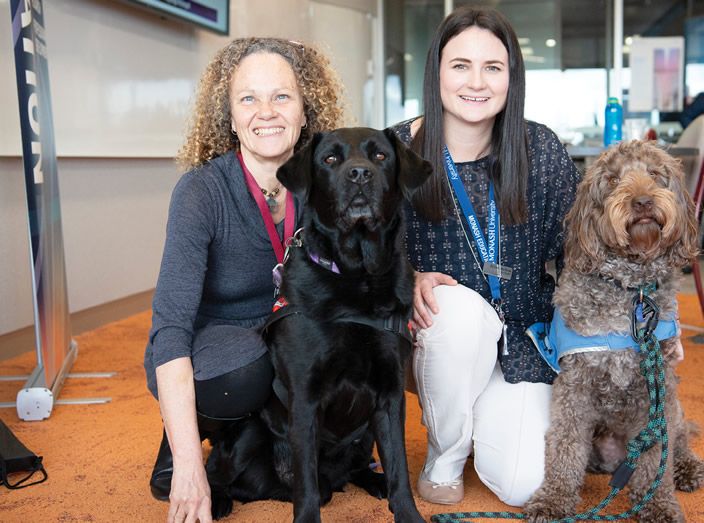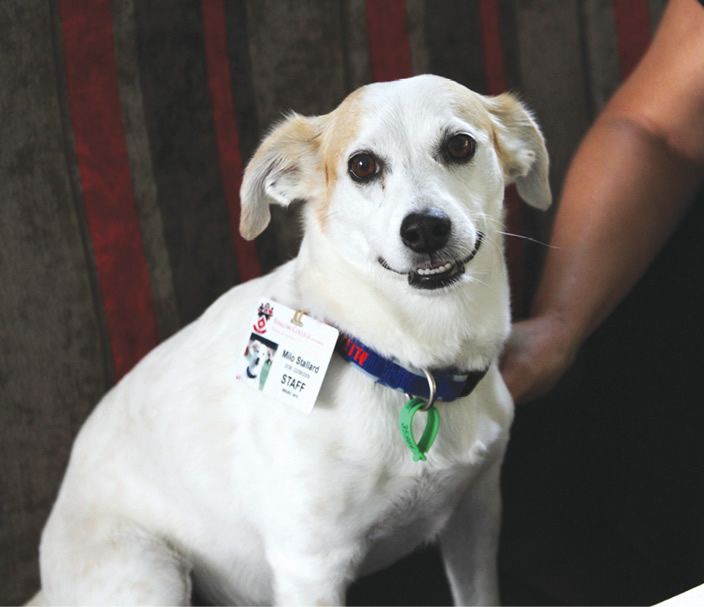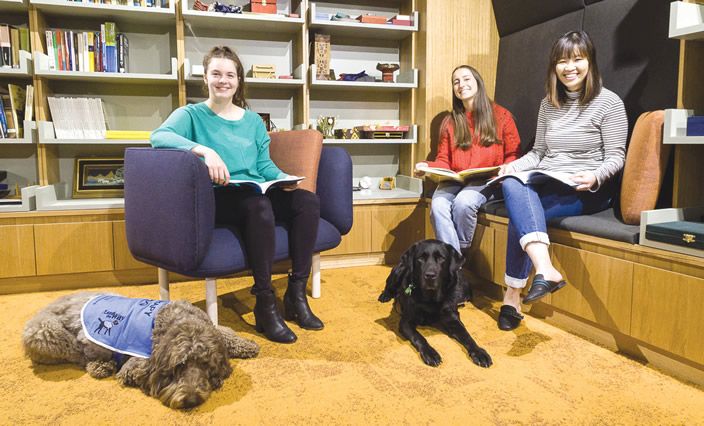“It was during this class he inadvertently was put in a position where he calmed down a very distressed student, and it was from there we looked into the role he could play as a more permanent member of staff at Shalom College.”
Milo has now been the school therapy dog for over 10 months, with a range of day to day duties that involve both in-class and playground involvement with the students.
“Milo comes along to all of my lessons both in the classroom and practical physical education classes. He also attends playground duties, visits with students at break times, as well as meetings with staff and parents,” Stallard said.
“During the classroom lessons, Milo roams freely, sitting with different students at different times, having a snooze or giving a hug where it’s sometimes needed.
“During the more physical classes, Milo also finds a way to be useful, such as during tennis matches where he dutifully retrieves out-of-bounds balls for the students.”
One of Milo’s most important roles is that of providing emotional comfort to students; if there is a student upset at school Milo will provide company during a visit at the school’s Student Services building.
“Students who are having a tough day emotionally especially benefit from Milo’s presence and it provides that circuit breaker to their feelings at a particular moment that can change the day for the better or provide some relief from their stress,” said Stallard.
“He has the ability to bring even the quietest of kids out of their shell, as they want to talk about their own pets while giving Milo a pat and cuddle and it allows them to open up as they feel comfortable with him.”
All members of the school community have reported positive reactions to Milo’s presence and his inclusion in learning activities has resulted in more constructive behaviours from students, especially those who are more challenging from a behavioural point of view.
“The students interact very positively with Milo and this enhances moods and behaviour rather than detract from it; those students who can, at times, be a distraction are positively influenced by Milo to behave in a more appropriate manner,” Stallard said.
“Collectively all our students are on the same page about Milo; they look forward to seeing him, they look out for him and they all relish the attention when he singles them out for some attention.”
What are therapy dogs?
It is important to understand the difference in roles between a therapy dog and a service dog, both of which may be found in an educational environment.
A service dog’s main purpose is to provide equal access for someone with a disability; they are protected by law in regards to their presence in certain animal-restricted areas and are trained specifically for an individual and their disability such as visual or hearing impairments, seizures, mobility issues or diabetes.
Therapy dogs have a less defined role, generally they are used to provide emotional support through animal assisted therapy which can come in many forms.
They are not protected by the same laws, meaning they can be refused access to animal restricted areas and activities such as using public transport.
What does the research tell us?
Dr Christine Grove is an Educational and Developmental Psychologist from the Faculty of Education at Monash University, who has trained her own dog, Bronson, to be a therapy dog.
Bronson works in both educational and clinical settings to help children overcome their fears.
Dr Grove is also undertaking research with her colleague Dr Linda Henderson and a team of Master of Educational/Development Psychology research students at the university, in relation to how therapy dogs impact student wellbeing in educational settings.
“Our research is predominantly school focused, given our research team have educational backgrounds in educational psychology and teaching,” Dr Grove said.
“We are looking particularly at animal therapy interventions in the school setting and how therapy dogs can support school psychologists – and how they can be used as part of a therapeutic toolkit for coping and supporting students’ to self-regulate their emotions.”
Therapy dogs can play a significant role in the school setting as part of a wellbeing program, where the dog has a distinct purpose such as supporting students with anxiety and stress.
Their role in this scenario is to improve rapport between students and the handlers or psychologists; the presence of the therapy dog creates excitement for the student and, therefore, they have a positive connotation with the therapy session and are more inclined to attend and actively participate.
“As we know with adolescents in particular, sometimes asking for help is hard and so therapy dog intervention is a way to make this more appealing, as well as to teach pro-social skills,” Dr Grove said.
“You can also use therapy dogs for communication; kids can talk to them and the dog doesn’t react they just listen, so you can practice different ways of how to communicate around challenging topics.”
Research shows that the presence of a therapy dog can also promote students’ attendance at school, as students are more likely to attend class if they know they will see a therapy dog there.
“Therapy dogs can also be used more informally, such as welcoming students and creating a more friendly and interactive environment,” Dr Grove said.
“Most students can benefit from interacting with a therapy dog as they are supportive for people dealing with general stress, including students who may have challenges in the classroom.
“While therapy dogs in themselves do not directly improve students’ grades, they may have a secondary impact that improves academic outputs such as if students are more likely to come to school and some research suggests students are engaging more when therapy dogs are present.”
Introducing a new therapy dog
Even when therapy dogs are being used by schools in a more informal way, Dr Grove emphasises the importance of a two-way communication model between the school administration and the broader school community during the initial introduction of the dog to the school environment.
“It is essential to have clear communication with the school community and with parents and carers around the inclusion of the therapy dog, giving them an opportunity to provide commentary about the dog coming in, discussing the process and voicing any concerns.
“It is also important to have a wellbeing and inclusion policy that includes the therapy dog in it, stating what the dog’s purpose will be and why the therapy dog is coming to school and when.
“The policy should also have a risk assessment in place so that if something happens, the school has an outlined response, as well as a clear process for any issues or complaints.”
Therapy dogs may be introduced as long term participants in the school environment, such as attending regular classes or being used as part of the school’s wellbeing program, or they may be brought in for assistance in a short term crisis capacity.
“Therapy dogs can be effective when used during critical instances, such as if there is a fatality at a school, as well as in ongoing interventions and treatments in schools in the setting,” Dr Grove said.
“Our research is attempting to determine if it helps having a therapy dog as part of the student wellbeing team or not.
“It is a really exciting space and hopefully within the next year we will have some more research published in this fast-moving field, where research is catching up with practice.”
References
https://www.deltasociety.com.au
https://theconversation.com/therapy-dogs-can-help-reduce-student-stress-anxiety-and-improve-school-attendance-93073





































































































































